
Cloud-based Platform-as-a-service (PaaS) enables developers and business users to create and maintain business applications with ease. PaaS comes pre-bundled with scripting languages for extensions, a development interface, runtime environment, data store, web server, and infrastructure. Scripting languages that come with PaaS typically enable new applications to be created with few lines of code compared to thousands of lines of code with traditional languages.
Contents
IaaS vs PaaS vs SaaS
While PaaS provides a platform to build and launch applications, Infrastructure-as-a-Service (IaaS) provides core compute/storage/network to enable customers to build their custom applications. Software-as-a-Service (SaaS) on the other end is typically pre-built domain-ready business functions that can be configured for each enterprise. In recent times, SaaS has been gaining a lot of popularity as enterprises don’t have to spend valuable resources in building non-differentiating capabilities and can focus on the core business needs instead. All the three layers of IaaS, PaaS, and SaaS insulate businesses for upgrades and typically bring in new marketplace capabilities as part of their roadmap.
The key differences across IaaS, PaaS, and SaaS are:
|
| IaaS | PaaS | SaaS |
| Application |
|
| √ |
| Data |
|
| √ |
| Runtime |
| √ | √ |
| Integrations |
| √ | √ |
| Operating System | √ | √ | √ |
| Virtualization | √ | √ | √ |
| Storage | √ | √ | √ |
| Compute | √ | √ | √ |
| Networking | √ | √ | √ |
| Marketshare | 21.00% | 15.00% | 64.00% |
PaaS is a key enabler in digital transformation. Digital transformation is a broad term; it encompasses many things in an organisation. Some of the key elements of digital transformations are: move to digital (automate across all steps in a process, no paper), minimal effort (click), predictive processes (guide the user), cloud-based (accessible from anywhere), and multi-device. All PaaS platforms come with multi-device and cloud-based features by default. PaaS platforms also embed best practices from global customers, analyst feedback, and market trends. PaaS platforms will become a key enabler for digital transformation as they provide a platform for organisations to build business capabilities in an agile manner and also tap into the new innovations that platforms bring in constantly.
Organisational impacts of PaaS
PaaS help streamline business operations. Organisations are able to save and manage valuable resources with more effectiveness. The key benefits PaaS brings to the organisation are:
- Agility: PaaS platforms architect what is frequently needed for the development of UI components, data access, ease of integration, the scripting language for extensions, and so on. This will reduce the overall time required to launch a platform.
- Future proof: PaaS platform providers are in line with market changes and provide regular updates to the platforms. This ensures that the organisations get newer features at timely intervals.
- Cost: Organisations don’t have to spend time and cost on creating features that are available on PaaS platforms. This greatly reduces the overall development cost and maintenance cost. However, the platform’s license is based on parameters such as the number of users, CPUs, etc. This needs to be firmly evaluated.
- Security: Platform providers typically upgrade with current security needs which are passed onto the organisations.
PaaS providers in today’s world
PaaS providers can be broadly classified as compute (infra) and application-centric.
Key providers in the compute-centric areas are Microsoft Azure, Amazon Web Services (AWS), Google Cloud, and OpenStack. Key providers in the application-centric areas are Salesforce Lightning, ServiceNow, Oracle, and Zoho.
Is PaaS the right way forward?
This is the tricky part. It will be wise to know the business needs – current and future. Many times nuances in usage greatly influence the business capability and commercials. Some of the key aspects that influence the decisions are:
- Tenancy and at what level
- User spread (active, inactive, concurrent)
- Pre-built widgets and apps
- Compute needs
- Security
- Marketplace to support extensions
- Commercials.
It is also a good practice to create prototypes specific to the planned business scenarios to shortlist PaaS providers.
What the future holds for PaaS?
Gartner predicts that the PaaS market will grow significantly from US$46.3 million in 2020 to US$71.5 million in 2022. While SaaS will be a key factor in non-core functions such as Human Resources (HR), PaaS will be key to creating differentiating business capabilities for an organisation (e.g.: Customer experience platforms). So, PaaS will continue to stay and expand. They will bring in new capabilities such as metaverse, experience enablers, and advanced analytics and enable organisations to stay relevant.
Conclusion
PaaS platforms typically enable developers to build apps with minimal code. Yes, there is a learning curve and it is faster than learning traditional languages. From the developers’ perspective, there is no dependency on the IT team to deploy infrastructure and applications as PaaS is already available in the cloud. In an agile world, PaaS helps in creating quick prototypes as well to get business buy-ins.
















